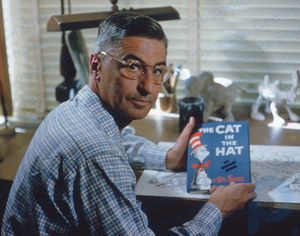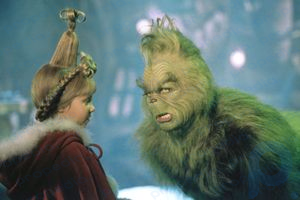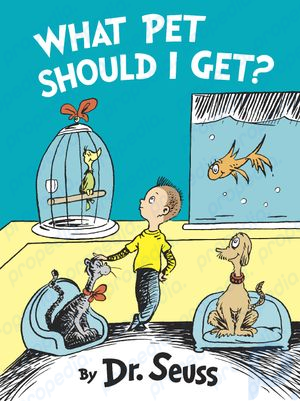


In 1947 Geisel returned to children’s books with McElligot’s Pool, about a boy who imagines a fantastical marine world while fishing. The work was especially noted for Geisel’s inventive creatures, which would come to populate his later stories. In addition, he continued to use his whimsical rhymes to convey important life lessons. In Horton Hears a Who! (1954), the loyal pachyderm returns to protect a tiny speck of a planet known as Whoville. A discussion about minority rights and the value of all individuals, the work features Horton repeating “a person’s a person, no matter how small.” In 1957 Geisel published two of his most popular works: The Cat in the Hat and How the Grinch Stole Christmas!. The former features a mischievous talking cat who entertains two bored children on a rainy day, while the latter introduces the Scrooge-like Grinch, who wants to ruin Christmas in Whoville but ultimately discovers that the holiday is more than just its material trappings. How the Grinch Stole Christmas! was later adapted (1966) for television, and it became a holiday staple. It was also made into a feature film (2000), a Broadway musical (2006), and an animated movie (2018).
In 1958 Geisel founded Beginner Books, Inc., which in 1960 became a division of Random House. He subsequently wrote a number of books for beginning readers, notably One Fish Two Fish Red Fish Blue Fish (1960), Green Eggs and Ham (1960), Hop on Pop (1963), and Fox in Socks (1965). They—along with his other works—went far beyond the traditional, and often boring, primers and were valued for their contribution to the education of children. During this period, Geisel also wrote The Lorax (1971), in which he expressed concern for the environment. The cautionary tale centres on a businessman who destroys a forest of Truffula trees—despite the protest of the Lorax, who speaks up because “the trees have no tongues”—and, when left with a desolate landscape, laments the damage he has caused. Giesel’s later notable books included the inspirational Oh, the Places You’ll Go! (1990), which became a popular graduation gift.
In 1984 Geisel received a special Pulitzer Prize “for his special contribution over nearly half a century to the education and enjoyment of America’s children and their parents.” The honour underscored the immense popularity of his works, which were perennial best sellers. According to various reports, by the early 21st century more than 600 million copies of Dr. Seuss books had been sold worldwide.
Other work

Geisel also designed and produced animated cartoons for television, many of them based on his books; he won Emmy Awards for Halloween Is Grinch Night (1977) and The Grinch Grinches the Cat in the Hat (1982). In addition, several of his books were adapted as feature films in the 21st century. In 1948 Geisel moved to La Jolla, California, where he lived until his death in 1991. He annually conducted a children’s workshop at the La Jolla Museum of Art. A large collection of his papers was housed at the University of California, San Diego. The university’s library was named the Geisel Library in his honour in 1995.

Some of Geisel’s early tales for children were posthumously collected as The Bippolo Seed, and Other Lost Stories (2011) and Horton and the Kwuggerbug, and More Lost Stories (2014). The book What Pet Should I Get?, discovered by his widow in 2013, was published in 2015.
The Editors of Encyclopaedia ProPediaThis article was most recently revised and updated by Amy Tikkanen.
